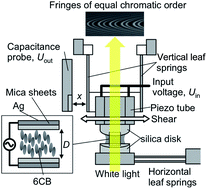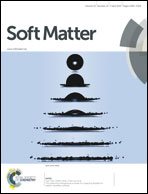Effect of confinement on electric field induced orientation of a nematic liquid crystal†
Abstract
We report the effect of confinement on the electric field induced orientation of a nematic liquid crystal, 4-cyano-4′-hexylbiphenyl (6CB), between mica surfaces. The resonance shear measurement was employed for monitoring changes in the viscosity of 6CB at various surface separation distances (D) with and without an applied electric field. The viscosity depended on the surface separations, and the behaviour for D < ca. 20 nm was quite different from that at D > ca. 20 nm. For D > ca. 20 nm, the viscosity values obtained in the presence of the electric field (ac 1 kHz, 1.87 kV mm−1, homeotropic orientation) were ca. 2 times higher than the values obtained without the electric field (0 kV mm−1, planar orientation) due to the difference in the molecular orientation, and were nearly constant. At D < ca. 20 nm, the viscosity of 6CB both with and without the electric field sharply increased and they merged into an identical value at D = 12.5 ± 1.3 nm (Dc), then exhibited a plateau up to D = 6 nm. With the decreasing distance below 6 nm, the viscosity of confined 6CB both with and without the electric field further increased up to more than 100 N s m−1 at the hard wall thickness of D = ca. 4.0 nm. These results indicated that 6CB molecules both with and without the electric field had the same orientation at D < Dc. The most likely orientation of 6CB was parallel to the surfaces because 6CB was originally in a planar orientation on the mica surface. These results demonstrated for the first time that the effect of confinement exceeded the electric field, thus 6CB molecules could not change their orientation under the electric field at the surface separation below Dc.


 Please wait while we load your content...
Please wait while we load your content...